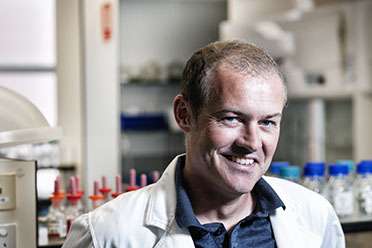Professor Anthony O'Mullane
The next-gen battery to enable electric cars to run longer and increase the storage capacity for solar energy is on its way thanks to QUT, CSIRO and RMIT researchers' discovery of a simple salt-bath process for rechargeable lithium batteries.
The research was published in Nature Communications today.
Pre-treating the lithium metal component of a rechargeable lithium battery in a salt bath increased its storage capacity, which enabled the battery to run longer and also stopped the chance of catching fire, QUT's Associate Professor Anthony O'Mullane said.
"Ultimately this discovery will accelerate the development of the next generation of batteries – lithium-air and lithium-sulphur systems," Professor O'Mullane said.
"These next generation batteries will have increased energy density and therefore last longer and store more energy compared to current graphite based technologies."
"These batteries will be safer because they won't need flammable organic solvents inside the batteries."
Professor O'Mullane said the process was straightforward whereby lithium metal electrodes were immersed in an electrolyte bath containing an ionic liquid and lithium salts.
"Ionic liquids are a unique class of material that are clear, odourless, non-flammable solutions that add a protective film onto the surface of the lithium electrode.
"This stabilises the battery and reduces the breakdown of electrolytes, thus increasing and prolonging the battery's performance."
RMIT's Dr Andrew Basile said it would mean batteries having to be charged less often, or providing more power from a single battery.
CSIRO researcher Dr Anand Bhatt said electric cars could, with this battery, be able to run for 500-800km on a single charge instead of the 100 to 250 km range of electric vehicles at the moment.
"It's an ideal device for electric vehicles giving them 500-800km on a single charge compared to the 100-250 km being seen or claimed for current electric vehicles," he said.
More information: A. Basile et al. Stabilizing lithium metal using ionic liquids for long-lived batteries, Nature Communications (2016). DOI: 10.1038/ncomms11794
Journal information: Nature Communications
Provided by Queensland University of Technology





















